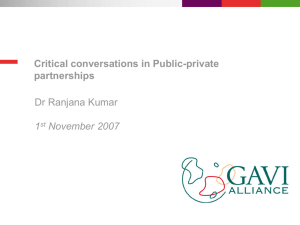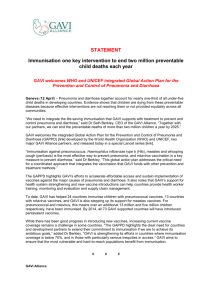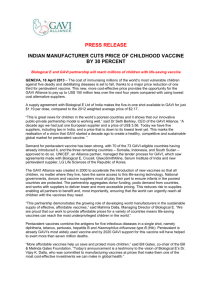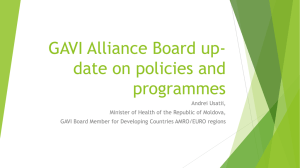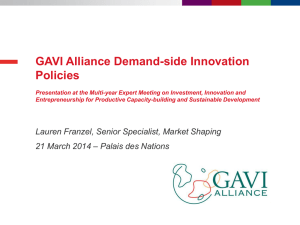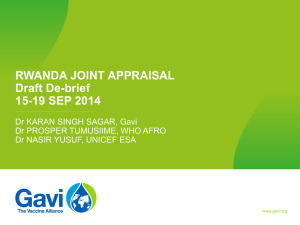Katherine Vyborny
advertisement
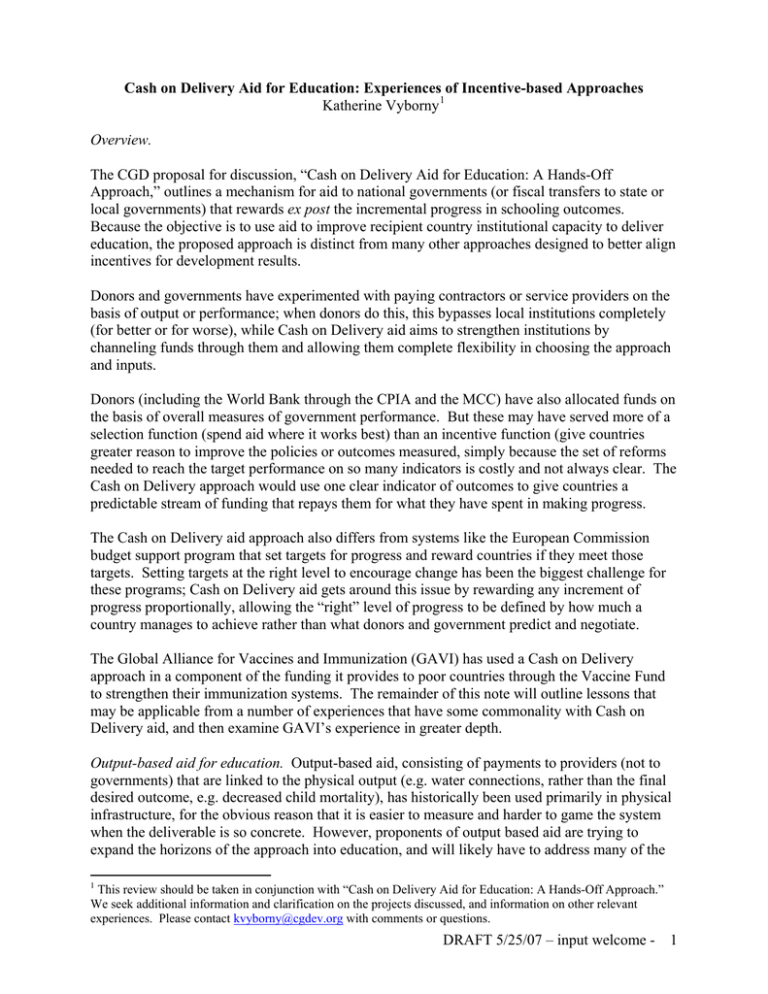
Cash on Delivery Aid for Education: Experiences of Incentive-based Approaches Katherine Vyborny 1 Overview. The CGD proposal for discussion, “Cash on Delivery Aid for Education: A Hands-Off Approach,” outlines a mechanism for aid to national governments (or fiscal transfers to state or local governments) that rewards ex post the incremental progress in schooling outcomes. Because the objective is to use aid to improve recipient country institutional capacity to deliver education, the proposed approach is distinct from many other approaches designed to better align incentives for development results. Donors and governments have experimented with paying contractors or service providers on the basis of output or performance; when donors do this, this bypasses local institutions completely (for better or for worse), while Cash on Delivery aid aims to strengthen institutions by channeling funds through them and allowing them complete flexibility in choosing the approach and inputs. Donors (including the World Bank through the CPIA and the MCC) have also allocated funds on the basis of overall measures of government performance. But these may have served more of a selection function (spend aid where it works best) than an incentive function (give countries greater reason to improve the policies or outcomes measured, simply because the set of reforms needed to reach the target performance on so many indicators is costly and not always clear. The Cash on Delivery approach would use one clear indicator of outcomes to give countries a predictable stream of funding that repays them for what they have spent in making progress. The Cash on Delivery aid approach also differs from systems like the European Commission budget support program that set targets for progress and reward countries if they meet those targets. Setting targets at the right level to encourage change has been the biggest challenge for these programs; Cash on Delivery aid gets around this issue by rewarding any increment of progress proportionally, allowing the “right” level of progress to be defined by how much a country manages to achieve rather than what donors and government predict and negotiate. The Global Alliance for Vaccines and Immunization (GAVI) has used a Cash on Delivery approach in a component of the funding it provides to poor countries through the Vaccine Fund to strengthen their immunization systems. The remainder of this note will outline lessons that may be applicable from a number of experiences that have some commonality with Cash on Delivery aid, and then examine GAVI’s experience in greater depth. Output-based aid for education. Output-based aid, consisting of payments to providers (not to governments) that are linked to the physical output (e.g. water connections, rather than the final desired outcome, e.g. decreased child mortality), has historically been used primarily in physical infrastructure, for the obvious reason that it is easier to measure and harder to game the system when the deliverable is so concrete. However, proponents of output based aid are trying to expand the horizons of the approach into education, and will likely have to address many of the 1 This review should be taken in conjunction with “Cash on Delivery Aid for Education: A Hands-Off Approach.” We seek additional information and clarification on the projects discussed, and information on other relevant experiences. Please contact kvyborny@cgdev.org with comments or questions. DRAFT 5/25/07 – input welcome - 1 same challenges PBA would have in the areas of assessing quality and forestalling cheating. The World Bank’s Global Partnership on Output Based Aid raised the issue with an overview paper on how this approach had been used in U.K. schools. Spurred by problems with the quality of physical infrastructure in schools in the medium term, local governments in the U.K. have experimented with output-based contracts since the late 1990s. As the approach was developed further, the contracts expanded to computer labs for students, and contractors’ payment was linked first to student usage of these facilities, then to test scores (up to 15% of the contractors’ payment depended on these outcomes after a phase-in period) 2 . These developments are recent and to our knowledge have not yet been evaluated. If the push to expand OBA into education is successful, future applications of output-based aid in education in developing country contexts may have useful lessons for Cash on Delivery aid. U.S. high-stakes testing and bonuses. The controversial No Child Left Behind Act included bonuses both for schools and for states that met its accountability standards. The problem that states define for themselves what constitutes an acceptable level of competence has been widely discussed in the domestic context, as has concern about the incentive to focus on students at the threshold level to the exclusion of the needs of both gifted and the neediest students. These are issues that could be addressed in Cash on Delivery aid for education depending on the testing requirement included. NSF’s STEP program for U.S. graduation in technical fields. The National Science Foundation has awarded approximately $100 million since 2003 in grants to universities and colleges to increase the number of graduates in science, technology, mathematics and related fields. 3 The grants are made through a traditional approach in which university teams submit a proposal and a plan with numerical targets of the number of additional graduates a program should generate. Like Cash on Delivery aid, it gives broad flexibility in how that is accomplished: bridge programs from community college to university level and distance or internet courses have been funded under this program. The institutions must demonstrate progress towards this target to receive renewal of the grant. Evaluation of the STEP program is planned, and may include assessment both of the impact on graduation rates and of whether quality was impacted. UNIDO business environment capacity building in Morocco. The IRIS Center at the University of Maryland and UNIDO initiated a competitive performance-based allocation of credit for technical assistance, in which local governments would choose reforms to improve the local investment environment from a menu determined through a consultative process with business, government and civil society beforehand. UNIDO would evaluate both participating and nonparticipating municipalities and give them a “star” rating for the investment environment before and after the competition. 4 Technical assistance would be provided throughout the competition, but the winners would receive “credits” that could be redeemed for desirable TA, such as funding to promote the municipality on the Web or to send delegations to trade and investment fairs. The reward structure would be determined “rapidly” before the competition began through 2 David Goldstone. Pursuing output-based education: The evolution of contracts for schools in the United Kingdom. p.85 <http://rru.worldbank.org/Documents/Other/14ch9.pdf> 3 National Science Foundation. Science, Technology, Engineering, and Mathematics Talent Expansion Program (STEP) Program Solicitation NSF 06-502 <http://www.nsf.gov/pubs/2006/nsf06502/nsf06502.pdf> 4 Clifford Zines and Patrick Meagher. “Premeditated Inter-Jurisdictional Competition in Morocco to Strengthen Local Governance and Increase Donor Effectiveness” IRIS Center, University of Maryland, 2004. p.18 <http://www.isnie.org/ISNIE04/Papers/Zinnes%20and%20Meagher.pdf> DRAFT 5/25/07 – input welcome - 2 a complex system of contingent valuation surveys and game experiments to attempt to set a value to the political and other costs for local leaders of implementing specific reforms. It had in common with the Cash on Delivery approach that it would reward the direct outcomes sought with an input, but differed in circumscribing the input substantially. It also had a substantial predesigned research component, in which some qualifying municipalities would be de-selected from the competition (and receive a “consolation prize”) to serve as a control group. We are trying to find further information on whether this project moved past the initial stage; it may have been too complex and run into challenges. This experience may serve to highlight the importance of balancing multiple priorities (including locally driven agenda and the research agenda) with the simplicity that is an important part of why the Cash on Delivery aid approach is attractive on a number of fronts. EC budget support. The European Commission allocates budget support with both a fixed and a variable tranche; 612 million euros have been provided to date through this variable tranche. 5 The amount of the variable tranche depends on whether the recipient met mutually agreed targets in a range of public finance, health outcome, and education outcome indicators as measured by the government’s (theoretically) pre-existing internal PRSP review process. Interestingly, a review of the program did not address concerns about the impact of the incentive on the data produced. The same review concluded that the variation caused by different attainment in these indicators was only 8% of the amount disbursed, because only a portion of support was variable, and between 65-75% of the tranche was disbursed, a relatively small range between the high performers and low performers on the indicators. 6 For health and education there was a broader range but again affecting a still smaller subset of the funds. The impact of this on incentives would likely depend on how the budget support is allocated to various programs and whether the marginal gain or loss was allocated to the sector “responsible” for bringing in the additional resources by meeting the targets. The report acknowledged that “the choice of targets has often proved more difficult than the choice of indicators.” 7 Australian support for forest cover. The Australian government is beginning an initiative that would link aid transfers to aerially recorded measurements of forest cover. Robin Davies, head of this initiative, will be participating in a brainstorming session on Cash on Delivery aid at CGD and we hope to hear more about the program and its progress. GAVI. GAVI’s Immunization Support Services program funds countries as a part of a funding package on an application basis. ISS is intended to build country capacity for immunization. Countries present a plan for increasing childhood immunization rates, and if approved receive both an initial payment and ex post reward shares on the basis of their progress. Because this program uses a Cash on Delivery mechanism similar to the proposed approach, we will consider aspects of GAVI’s experience (from an ISS programwide evaluation, country case studies, and a survey of officials in recipient countries) and how they might apply in education in depth below. Selection of recipients. A PBA approach needs a mechanism to choose which countries (or districts) to receive funds. Programs can use eligibility criteria to select the targeted recipients, 5 6 European Commission, DG Development. “EC Budget Support: An Innovative Approach to Conditionality.” February 2005. p.2 <http://spa.synisys.com/resources/2005/EC_GBS_VT_Review.pdf> 7 European Commission, DG Development. “EC Budget Support: An Innovative Approach to Conditionality.” February 2005. p.33 <http://spa.synisys.com/resources/2005/EC_GBS_VT_Review.pdf> DRAFT 5/25/07 – input welcome - 3 require an application for proof of need, or attempt to design the program for self-selection. GAVI funds are targeted towards countries with relatively low levels of immunization for DTP>3 (diphtheria, tetanus and pertussis) (80% or less). 8 A study of the experiences of GAVI recipient country officials brought up the suggestion that this be expanded, in particular because of the increasing marginal cost of improving this indicator: increasing the coverage rate from 60 to 70% is much easier than raising it from 90 to 95%. 9 Some higher-income countries also pointed out that this indicator is not representative of their overall immunization coverage, because they had low coverage of vaccines in other diseases; for better or worse, the criteria effectively targeted low-income countries. Requiring and vetting a plan as a prerequisite to funding brings an element of donor input into how the money is spent, although it is still less intrusive than more active donor involvement. It may be necessary if initial startup funds are provided, and may have some benefits of structuring the planning process to program the funds; however, the process of making the case to donors is often costly, and depending on the real and perceived criteria on which they are evaluated, can easily become a different mechanism for conditionality, and the policy and management agenda is driven by donor priorities. Under the GAVI ISS program, countries apply for packets of funding, and lay out a plan for how they will increase immunization rates. However, GAVI conscientiously avoids creating additional work and duplication for recipient countries, wherever possible requesting existing forms rather than new ones, for example. Unit of Progress. Cash on Delivery aid programs have to define the unit of progress rewarded, and find an acceptable way to assess the baseline situation for reliable evidence of progress. Most incentive-based programs set or require recipients to set specific targets, which could transform the incentives involved, depending on the baseline level, the way recipients are rewarded for meeting, exceeding, or improving but falling short of the target, and the cost structure they face in reaching these levels. GAVI linked payments with vaccination coverage for DTP>3 because it is a vital and basic vaccine for which coverage rates should be easily improved with increased capacity. There was some risk that countries would substitute out of other health resources or other vaccines to achieve coverage. The issue of the benchmark and how to measure it would be crucial for Cash on Delivery aid for education. The proposed approach requires that students take competency tests, but not that they pass, to receive the payment, to improve information for parents and communities as well as researchers and policymakers to push for improvement, while reducing the incentives for cheating. Timing and amount of payment. The payment could be set to try to approximate the cost of making progress, although this presents problems with the almost universal situation of diminishing marginal returns to spending – as vaccination coverage rates or primary school completion increase, the remaining excluded groups or areas are likely the hardest to reach. Alternatively, it may be structured to intentionally exceed the cost, to enhance the incentive for progress. GAVI set the reward share payment at $20 per child immunized, which was based on 8 The Global Alliance for Vaccines and Immunizations. “Evaluation of GAVI Immunization Services Support Funding.” August 2004. p.ix <http://www.changeproject.org/pubs/GAVI_ISS_Final.pdf> 9 The Global Alliance for Vaccines and Immunizations. “Evaluation of GAVI Immunization Services Support Funding.” August 2004. p.ix <http://www.changeproject.org/pubs/GAVI_ISS_Final.pdf> DRAFT 5/25/07 – input welcome - 4 the approximate “cost of fully immunizing a child” in their recipient countries. 10 The proposed approach for education explicitly includes an additional reward that can be spent in any way the country chooses. This is likely to be a powerful incentive, as countries could do whatever works to get students to school, even build roads if transport was the constraint on students’ attendance, or pay parents or local leaders with conditional cash transfers. It should also help address the issue that GAVI recipients brought up in one study of the higher cost of reaching the most excluded populations. But if a country is already experiencing increasing enrollment due to other factors (demographic, economic, or even because of the last round of aid for education) officials could pocket the difference – and that could make the program politically short lived. The decision of whether to include an initial payment up front is likely to be a defining one. Requiring progress without any extra resources up front may create a challenge, although in some countries existing aid flows for education are significant, and if the program is additional it may not present an obstacle. However, if countries borrow against a future reward payment, they may end up involved in the same types of complex conditionalities that Cash on Delivery aid was designed to avoid! Donors would certainly require that some kind of plan be presented for how to spend the advance – thus bringing them back into the policy picture. An up front payment of course also bears risks: anecdotally, one GAVI recipient is said to have broadly overestimated the likely level of immunization that could be reached to increase the advance payment, and promptly spent the money on cars for government officials.11 How long will donors continue to pay? The issue of sustainability (an exit strategy for donors) is key. This is currently a pressing concern for GAVI, and recipients have urged that the five-year program be extended to ten to achieve long term capacity for immunization. 12 One option in education would be to use a moving baseline, so donors would pay in 2010 for the additional number of students over the 2005 level, and so on. This would also keep the incentive operating steadily. Credibility of the contract. GAVI requires that countries pass a Data Quality Audit (with a score of .80) to receive reward shares; the DQA is expressly geared towards improving the capacity for data collection, and countries can continue to receive basic ISS funding as they improve the data on immunization coverage 13 . The DQA includes an interview and survey component with officials, and a component that is similar to an accounting audit. Districts are chosen randomly, and a team of both external and national auditors checks the consistency of the record books of the clinics with regional level data. Several of the countries improved data significantly over the course of the program, and the GAVI evaluation notes that this incentive “appears to have had significant impact in motivating countries to address the problem of data quality,” which is an important objective of the proposed education program as well. 14 10 The Global Alliance for Vaccines and Immunizations. “Evaluation of GAVI Immunization Services Support Funding.” August 2004. p.ix <http://www.changeproject.org/pubs/GAVI_ISS_Final.pdf> 11 Natasha Hsi and Rebecca Fields. “Evaluation of GAVI Immunization Services Support Funding Case Study: Kenya” <http://www.changeproject.org/pubs/GAVI_Kenya_final.pdf> 12 The Global Alliance for Vaccines and Immunizations. “Evaluation of GAVI Immunization Services Support Funding.” August 2004. <http://www.changeproject.org/pubs/GAVI_ISS_Final.pdf> 13 The Global Alliance for Vaccines and Immunizations. “Evaluation of GAVI Immunization Services Support Funding.” August 2004. p.ix <http://www.changeproject.org/pubs/GAVI_ISS_Final.pdf> 14 The Global Alliance for Vaccines and Immunizations. “Evaluation of GAVI Immunization Services Support Funding.” August 2004. p.xvi <http://www.changeproject.org/pubs/GAVI_ISS_Final.pdf> DRAFT 5/25/07 – input welcome - 5 Applying this principle to testing and in particular school completion, which takes place over more time and space, will be a significant challenge for the Cash on Delivery aid approach. We welcome suggestions of experts in this area to engage in the discussion of how an independent audit to such a contract could be designed. Risk management. GAVI seems to be primarily using input from recipient countries to consider changes to aspects of the ISS mechanism. The use of a moving baseline, discussed above, could help adjust for possible negative shocks, such as a drought the year after the baseline study was conducted. To further address the volatility issue, a three-year moving average could be used. At least one issue has arisen GAVI has not resolved. In Kenya, officials decided to use official administrative estimates of coverage rates for the baseline, which were higher than the rate suggested by the population survey data. 15 With turnover in the immunization program, a new staff is now dealing with the challenge that this poses: it sets the bar too high for any increase to likely be possible, so Kenya is unlikely to earn reward shares. The ISS program evaluation recommended implementing an appeals process of some kind to address such situations. A range of such situations could arise with the more complicated issue of school attendance and testing, and there may also be credibility issues on the donor side. What if donors do not pay as promised, or do not pay on time? A feasible contract would need some way of dealing with potential disagreements over the independent audit, baseline or other issues. Learning. GAVI sponsored thorough studies of what happened under the ISS program, both in terms of the data and the qualitative feedback of country participants. This includes detailed assessments of the change in countries’ capacity to manage the logistics of immunization and data to track it. To our knowledge, however, there has been only anecdotal discussion of the broader impact of the ISS program on institutions. We welcome input to the question of how this could be studied for GAVI and for a potential Cash on Delivery aid pilot in education. 15 Natasha Hsi and Rebecca Fields. “Evaluation of GAVI Immunization Services Support Funding Case Study: Kenya” <http://www.changeproject.org/pubs/GAVI_Kenya_final.pdf> DRAFT 5/25/07 – input welcome - 6
